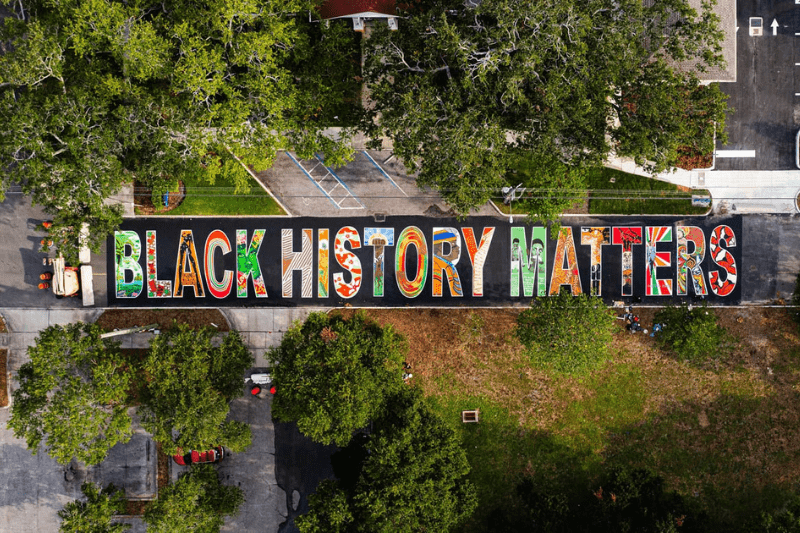
St. Petersburg Mayor Ken Welch says the city has no choice but to allow the Florida Department of Transportation (FDOT) to remove several street murals the state deemed noncompliant with a recent executive mandate.
The state has targeted five street murals in the city, including a Pride flag design in the Grand Central district and a Black History Matters street mural on the south side near the Woodson African American History Museum. Welch has said FDOT will remove the murals at the city’s expense.
But while the initial decision came with pushback, Welch defended his administration during a press conference at City Hall, noting that pushing back against the state was a losing strategy.
“When FDOT informed us that our non-standard surface markings, our street murals, had to be removed, we pushed back, utilizing every viable tool available to us. We submitted the requested inventories, we requested exemptions, we consulted with our attorneys and spoke with our stakeholders,” Welch said.
“We also provided data that shows that the markings actually increased safety based on historical data before and after the installation of the subject art. We made it clear that these murals are more than paint on pavement. They are expressions of our community identity and values.”
Unfortunately, he added, “FDOT made their position clear,” threatening “millions of dollars in state transportation funding and potentially tens of millions more in broader state funding in other areas” if the city did not comply with removal.
“As Mayor of our city, I will not risk these essential investments in a fight that I don’t believe we can win,” Welch said. “That would be irresponsible leadership and detrimental to our city in the long run.”
Instead, Welch said the city is already engaged in conversations about how best to honor St. Pete’s diverse communities and culture through public art installations on private and/or city-owned properties.
“Our response will be strategic, not reactionary. It may not be as emotionally satisfying as a street brawl,” Welch said. “We will build back stronger, and we will create new, even more powerful expressions of who we are, expressions that cannot be erased.”
Welch did not say when FDOT will remove the murals — they have yet to inform the city — but he encouraged residents to visit the murals while they still can and memorialize them with photographs. He also suggested sharing the images with hashtags such as “our streets, our voices,” and “can’t erase St. Pete.”
The intersections in question are at Central Avenue and 5th Street North; 6th Avenue and 2nd Street South; 9th Avenue and 22nd Lane South; Central Avenue and 25th Street North; and 11th Avenue and 46th Street South.
The inclusive Pride flag design is located at the Central Avenue intersection in Grand Central, while the Black History Matters mural is at 9th Avenue South in the Deuces.
The mural at 6th Avenue South, known as the Fluid Structures mural, is located at the University of South Florida St. Pete campus and was created by students “to reflect a new generation’s vision for St. Pete,” Welch said. It is not representative of the LGBTQ+ community or the Black Lives Matter movement, rather a series of brightly colored shapes and designs.
Another mural, located on Central Avenue in downtown St. Pete, is known as the Common Ground mural. It includes brightly colored geometric shapes that actually decreased traffic accidents at the intersection by 70%, according to Welch.
The Crux mural in Child’s Park, which was painted with local children, was designed specifically to reduce speed and increase safety for drivers, pedestrians and cyclists.
While Welch emphasized the city’s lack of options in fighting the street mural battle, he nevertheless expressed frustration with the latest in a long line of home rule attacks on Florida cities.
“It is always troubling when state or federal politicians attempt to usurp our local values and priorities, and instead mandate what our values should be,” he said. “We have seen repeated attempts to silence our voices, to change the definition of terms from ‘climate change’ to DEI, even banning the recognition of Black history and the LGBTQ community.”
But Welch said the city is resilient, and always rises to the occasion.
“This latest challenge will be no exception,” he said.
“Whatever is taken away will be replaced in new, more impactful ways,” the Mayor added. “And to those who think they can silence St. Petersburg, all you have done is amplify our voice. Our message will now travel farther and louder than ever before.”
While Welch is encouraging residents and visitors to view the murals while they still can, he also offered a warning rooted in actions in another city. Groups in Orlando gathered with sidewalk chalk to recolor a mural that had been erased at the site of the horrific 2016 mass shooting at the Pulse nightclub after the state erased the mural in the dead of night.
“Obey the law,” Welch said. “Don’t take the bait.”
Blocking an intersection, he reminded, is illegal, and Florida Highway Patrol is now out in force in Orlando enforcing that law.
Welch said he isn’t yet sure what would replace the doomed murals, adding that it could be public art on banners, poles or flags. He’s putting “all the creative minds in our city” on it.
St. Pete’s latest on its street murals follows threatening letters sent to several cities. St. Pete’s latest letter, which prompted Welch’s announcement that the city would not continue to fight the state on the issue, came Friday.
The letter stated that St. Pete was not in compliance with the Engineering and Operations Memorandum No. 25-01 regarding traffic control and street design, issued by Gov. Ron DeSantis.



